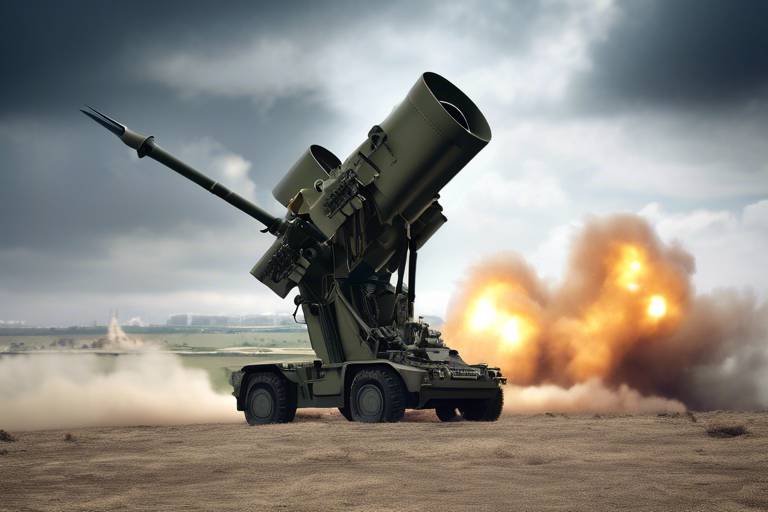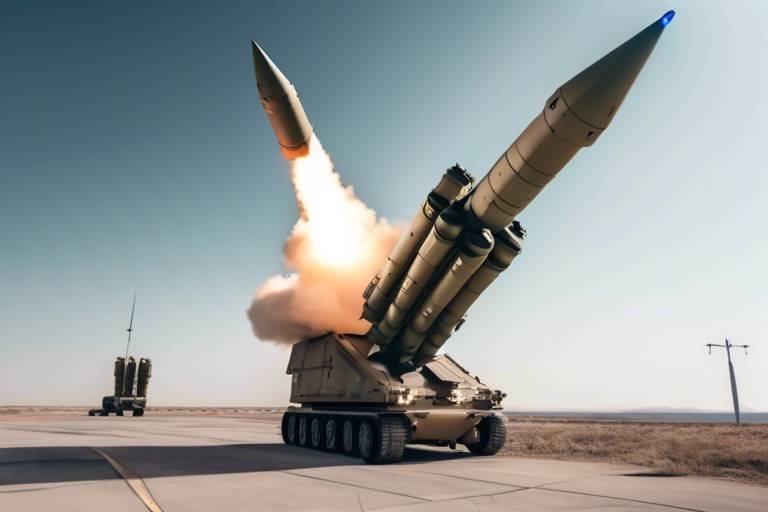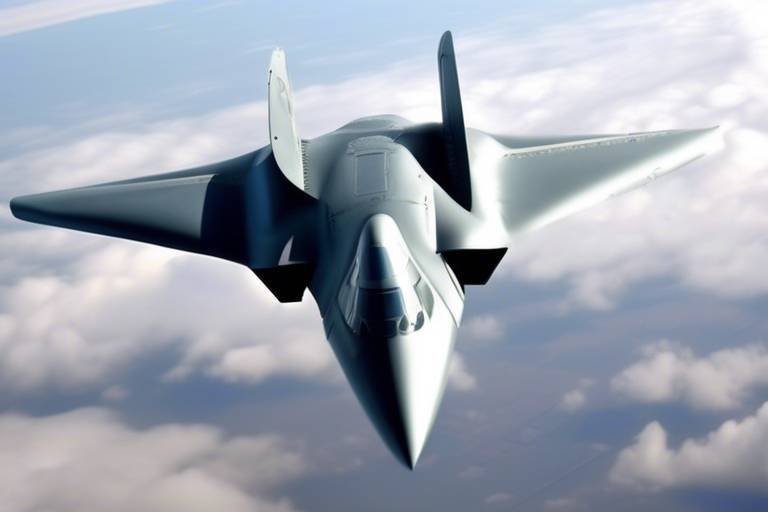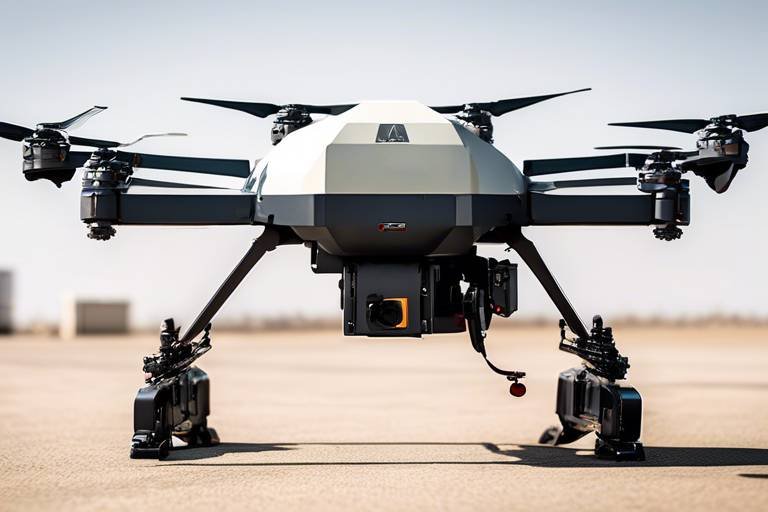Combat in the Cloud - The Future of Military Data Storage
In today's rapidly evolving technological landscape, the military is undergoing a transformation that is as profound as it is necessary. Cloud technology is not just a buzzword; it's a revolution that is reshaping how defense forces manage, store, and analyze data. Imagine a vast digital battlefield where information flows seamlessly, enhancing operational efficiency and ensuring that sensitive data remains secure. This is the essence of combat in the cloud.
Cloud computing offers the military scalable storage solutions that adapt to the fluctuating demands of modern warfare. Gone are the days when data was siloed in traditional storage systems, often leading to inefficiencies and delays in accessing critical information. With cloud technology, military personnel can access data from anywhere, at any time, which is crucial in high-stakes situations where every second counts. This newfound accessibility is akin to having a tactical advantage on the field, allowing for real-time decision-making that can turn the tide of operations.
Moreover, the importance of cloud technology in defense strategies cannot be overstated. As conflicts become more complex and data-driven, the military must leverage every tool at its disposal. Cloud solutions not only enhance data storage but also facilitate collaboration among forces, breaking down barriers that previously hindered communication. Imagine a scenario where troops in different locations can share intelligence instantaneously, leading to coordinated responses that are faster and more effective. This level of collaboration is a game changer, one that could redefine how military operations are conducted in the future.
However, while the benefits of cloud storage are immense, they come with their own set of challenges. Transitioning from traditional systems to cloud solutions requires careful planning and execution. Military organizations must address integration issues and overcome resistance to change, which can be a significant barrier. Yet, the potential rewards of embracing this technology far outweigh the challenges. Just as a soldier adapts to new equipment and tactics, so too must military organizations evolve with the times, embracing the cloud as an essential component of their operational framework.
As we look to the future, the role of cloud technology in military data storage will only continue to grow. With advancements in artificial intelligence and machine learning, the possibilities for optimizing data management and analysis are boundless. Picture a system that not only stores data but also analyzes it in real-time, providing actionable insights that can inform strategic decisions. This integration of cutting-edge technologies will undoubtedly enhance the military's operational capabilities, ensuring that they remain a step ahead of potential adversaries.
In conclusion, the future of military data storage lies in the cloud. It promises a world where data is not only stored securely but also analyzed and shared effectively, driving operational success. As military organizations embrace this technology, they will unlock new levels of efficiency and security, paving the way for a more agile and responsive defense force. The journey may be challenging, but the destination is a future where information supremacy is the norm, not the exception.
- What are the main benefits of cloud computing for the military?
Cloud computing provides scalable storage, enhanced accessibility, improved collaboration, and cost-effectiveness, all of which are crucial for military operations. - How does cloud technology ensure data security?
Cloud technology employs advanced encryption protocols and access control mechanisms to protect sensitive military data from cyber threats. - What challenges does the military face in adopting cloud solutions?
Challenges include integration issues with existing systems, resistance to change, and the need for robust training for personnel. - How will AI and machine learning impact military data storage?
AI and machine learning can optimize data management and analysis, offering real-time insights that enhance decision-making processes. - Is cloud technology the future of military operations?
Yes, as technology continues to evolve, cloud computing will play a critical role in shaping the future of military data storage and operational strategies.

The Rise of Cloud Computing in Defense
Cloud computing is not just a buzzword anymore; it's a game-changer in military operations. Imagine a world where data is as accessible as flipping a switch, where troops on the ground can access critical information in real-time, regardless of their location. This is the reality that cloud technology is creating for defense forces across the globe. The military is increasingly recognizing that traditional data storage methods can be cumbersome and inefficient. With the rise of cloud computing, defense strategies are evolving, allowing for scalable storage solutions that enhance operational efficiency and accessibility.
One of the most significant advantages of cloud computing in defense is its ability to provide scalable solutions. As military operations can fluctuate dramatically, the need for flexible storage that can grow or shrink according to demand is crucial. For instance, during a large-scale operation, data demands can skyrocket, requiring an immediate increase in storage capacity. Conversely, during peacetime, the military can scale back, optimizing costs and resources. This elasticity is something traditional data storage simply cannot offer.
Moreover, the accessibility of cloud storage means that military personnel can retrieve and share information quickly, fostering improved collaboration among different units. Imagine a scenario where a command center can instantly share intelligence with troops in the field. This kind of rapid information exchange can be the difference between success and failure in critical missions. The military is now able to leverage cloud technology to ensure that all personnel have access to the same data, leading to more synchronized operations.
However, the rise of cloud computing in defense is not just about convenience; it also involves a significant shift in strategy. Military leaders are beginning to understand that integrating cloud solutions is essential for staying ahead in modern warfare. The cloud allows for the integration of advanced technologies such as big data analytics and artificial intelligence, which can enhance decision-making processes. This is particularly vital in a landscape where information is power, and the ability to analyze vast amounts of data quickly can provide a tactical advantage.
Despite its many benefits, the transition to cloud computing in defense is not without challenges. Concerns around data security and the potential for cyber threats loom large in the minds of military leaders. However, as cloud technology continues to evolve, so too do the security measures that protect sensitive military data. The military is investing in advanced security protocols to ensure that their data remains secure, even in a cloud environment.
In conclusion, the rise of cloud computing in defense is reshaping how military operations are conducted. With scalable solutions, enhanced accessibility, and the integration of advanced technologies, the military is poised to operate more efficiently than ever. As we move forward, embracing these changes will be crucial for defense forces to maintain their edge in an increasingly complex global landscape.
- What are the primary benefits of cloud computing for military operations?
Cloud computing offers scalable storage, improved accessibility, and enhanced collaboration among military units, leading to more efficient operations. - How does cloud technology enhance data security in military applications?
Cloud technology employs advanced security protocols, including encryption and access control mechanisms, to protect sensitive military information from cyber threats. - What challenges do military organizations face when adopting cloud solutions?
Challenges include integration issues with existing systems, resistance to change among personnel, and concerns about data security. - What role do AI and machine learning play in military cloud storage?
AI and machine learning can optimize data management and analysis, providing military operations with valuable insights and improving decision-making processes.

Benefits of Cloud Storage for Military Operations
In today’s fast-paced military landscape, cloud storage has emerged as a game-changer, offering a plethora of benefits that enhance operational efficiency and effectiveness. Imagine a world where military personnel can access critical data from anywhere, at any time, without the cumbersome limitations of traditional storage systems. This is not just a dream; it's a reality made possible by cloud technology. One of the most significant advantages of cloud storage is its cost-effectiveness. By shifting to the cloud, military organizations can reduce the need for expensive on-premises infrastructure, which often requires extensive maintenance and upgrades. Instead, they can leverage scalable solutions that adapt to their needs, allowing them to allocate resources more efficiently.
Moreover, the rapid deployment capabilities of cloud storage cannot be overstated. In military operations, timing is everything. The ability to deploy applications and services quickly can mean the difference between success and failure on the battlefield. With cloud solutions, military units can swiftly set up new systems and access vital information without the delays typically associated with traditional IT setups. This agility not only enhances operational readiness but also fosters a culture of collaboration among forces. Teams can share data seamlessly, ensuring that everyone is on the same page and can respond to evolving situations with speed and precision.
Another critical benefit of cloud storage is its support for real-time data analytics. In military operations, having access to up-to-date information can be crucial for decision-making. Cloud platforms can process vast amounts of data quickly, providing insights that help commanders make informed choices on the fly. For instance, during missions, data collected from various sources can be analyzed in real-time to assess threats and opportunities, enabling a more proactive approach to combat. This level of situational awareness is invaluable and can significantly enhance mission success rates.
However, it’s essential to recognize that the transition to cloud storage is not without its challenges. Military organizations must address concerns regarding data security and compliance with regulations. Nonetheless, the benefits of adopting cloud technology far outweigh the drawbacks, making it a vital component of modern military strategy. As we look to the future, it’s clear that cloud storage will continue to play a pivotal role in shaping the way military operations are conducted.
- What are the primary advantages of using cloud storage in military operations?
Cloud storage offers cost-effectiveness, rapid deployment, enhanced collaboration, and real-time data analytics, all of which significantly improve operational efficiency. - How does cloud storage enhance data security for military data?
Cloud storage solutions implement advanced security protocols, including encryption and access control mechanisms, to protect sensitive military information from cyber threats. - What challenges do military organizations face when adopting cloud technology?
Challenges include integration issues with existing systems, resistance to change, and concerns about data security and compliance. - What future trends can we expect in military cloud storage?
Emerging trends include the integration of artificial intelligence and machine learning to optimize data management and improve interoperability with existing systems.

Enhanced Data Security Measures
In the realm of military operations, data security isn’t just important—it’s absolutely paramount. With the increasing reliance on cloud technology, the defense sector has recognized the need for robust security measures to protect sensitive information from a variety of cyber threats. The cloud offers a plethora of advantages, but without the right security protocols, those benefits could be overshadowed by vulnerabilities. This is where enhanced data security measures come into play, ensuring that military data remains safe and secure in the cloud.
One of the primary strategies for safeguarding military data is through the implementation of advanced encryption technologies. Encryption acts like a digital vault, encoding information so that only authorized users can access it. In military applications, where data can include classified information, troop movements, and strategic plans, encryption is non-negotiable. Various encryption methods, such as AES (Advanced Encryption Standard) and RSA (Rivest-Shamir-Adleman), are employed to secure data both at rest and in transit. This means that even if a cybercriminal intercepts the data, it would be nearly impossible to decipher without the correct keys.
Moreover, access control mechanisms play a vital role in protecting military data. These mechanisms ensure that only individuals with the appropriate clearance can access sensitive information. Role-based access control (RBAC) is a popular approach, where permissions are assigned based on the user's role within the organization. This minimizes the risk of unauthorized access, as personnel are limited to the data necessary for their specific duties. Coupled with strong authentication measures, such as multi-factor authentication (MFA), these controls create a formidable barrier against potential breaches.
To illustrate the effectiveness of these security measures, consider the following table that outlines key components of enhanced data security in military cloud storage:
| Security Measure | Description | Benefits |
|---|---|---|
| Encryption | Encoding data to prevent unauthorized access. | Protects sensitive information during storage and transmission. |
| Role-Based Access Control | Restricts data access based on user roles. | Reduces risk of data exposure by limiting access. |
| Multi-Factor Authentication | Requires multiple forms of verification to access data. | Enhances security by adding an extra layer of protection. |
In addition to these measures, continuous monitoring and auditing of cloud systems are essential. By regularly reviewing access logs and data usage patterns, military organizations can quickly identify any suspicious activity or potential breaches. This proactive approach not only helps in mitigating risks but also strengthens the overall security posture of military data stored in the cloud.
As we move forward in this digital age, the importance of enhanced data security measures cannot be overstated. With the stakes as high as they are in military operations, implementing these protocols is not merely a best practice; it’s a necessity. The defense forces must remain vigilant, adapting to new threats and ensuring that their data storage solutions are fortified against any potential attacks.
- What is cloud computing in military operations? Cloud computing refers to the use of remote servers hosted on the internet to store, manage, and process data, allowing military forces to access information from anywhere at any time.
- How does encryption protect military data? Encryption transforms data into a coded format that can only be read by someone with the correct decryption key, ensuring that even if data is intercepted, it remains unreadable to unauthorized users.
- What are role-based access controls? Role-based access controls limit data access based on a user's role within the organization, ensuring that only those who need access to certain information can view or modify it.
- Why is continuous monitoring important for cloud security? Continuous monitoring helps identify suspicious activities or potential breaches in real-time, allowing for quick responses to mitigate risks and protect sensitive information.

Encryption Technologies
In the realm of military data storage, play a pivotal role in ensuring that sensitive information remains confidential and secure. Imagine encryption as a high-tech lock on a vault that holds critical data; without the right key, accessing that information is nearly impossible. This is particularly crucial for military operations, where data integrity and confidentiality can mean the difference between mission success and failure.
There are several sophisticated encryption methods employed in cloud storage solutions, each designed to protect data during both transmission and storage. One of the most widely used techniques is AES (Advanced Encryption Standard), which encrypts data in blocks and is considered one of the most secure encryption methods available today. AES uses different key lengths—128, 192, or 256 bits—to provide varying levels of security, making it adaptable to different military needs.
Another important technology is RSA (Rivest-Shamir-Adleman), a public-key encryption method that enables secure data exchange over the internet. RSA is particularly useful for encrypting messages sent between military personnel, ensuring that only the intended recipients can access the information. Additionally, it facilitates digital signatures, which are essential for verifying the authenticity of communications.
To further enhance security, military cloud solutions often employ encryption at rest and encryption in transit. Encryption at rest protects data stored on servers, while encryption in transit secures data as it travels across networks. This dual-layered approach ensures that even if data is intercepted during transmission, it remains unreadable to unauthorized users.
Moreover, the implementation of homomorphic encryption is gaining traction in military applications. This advanced technology allows computations to be performed on encrypted data without needing to decrypt it first. Think of it as being able to work with a locked box without ever opening it—this capability is invaluable for analyzing sensitive military data while maintaining its confidentiality.
As military operations become increasingly reliant on cloud technology, the importance of robust encryption measures cannot be overstated. These technologies not only safeguard sensitive data but also bolster the confidence of military personnel in the systems they use. With the right encryption strategies in place, defense forces can operate more efficiently and securely, ensuring that their critical information remains protected against ever-evolving cyber threats.
- What is encryption technology?
Encryption technology is a method used to secure data by converting it into a code that can only be read by someone with the correct decryption key. - Why is encryption important for military data?
Encryption is crucial for military data as it protects sensitive information from unauthorized access and cyber threats, ensuring operational security. - What are the different types of encryption used in military applications?
The military commonly uses various encryption methods, including AES for data at rest, RSA for secure communications, and homomorphic encryption for processing data without exposing it. - How does encryption at rest differ from encryption in transit?
Encryption at rest protects data stored on servers, while encryption in transit secures data as it moves across networks, providing a comprehensive security approach.

Access Control Mechanisms
In the realm of military data storage, serve as the frontline defense against unauthorized access and potential data breaches. Think of these mechanisms as the armed guards at a high-security facility, ensuring that only those with the right credentials can enter. The military's need for robust security is paramount, as sensitive information can have far-reaching implications if it falls into the wrong hands. So, how do these mechanisms work, and why are they so crucial?
At the core of effective access control is the principle of least privilege. This means that personnel are granted the minimum level of access necessary to perform their duties. For instance, a soldier might need access to specific operational data, but not to sensitive intelligence reports. By limiting access, the military can significantly reduce the risk of data leaks or misuse. In cloud environments, this is often achieved through role-based access control (RBAC), which assigns permissions based on the user’s role within the organization.
Moreover, authentication measures play a vital role in controlling access. Gone are the days when a simple password was enough. Today, military organizations employ multi-factor authentication (MFA) to add an extra layer of security. This could involve a combination of something the user knows (like a password), something they have (like a security token), and something they are (like a fingerprint). This triad of verification dramatically enhances security by making it much harder for unauthorized users to gain access.
Furthermore, audit trails are a critical component of access control mechanisms. These logs track who accessed what data and when, providing a comprehensive record that can be invaluable for forensic analysis in the event of a security breach. Imagine having a detailed map of every movement within a secure facility; this level of oversight ensures that any suspicious activity can be quickly identified and addressed.
In addition to these measures, the military is increasingly adopting advanced technologies such as artificial intelligence (AI) to bolster access control. AI can analyze patterns of behavior and detect anomalies that might indicate unauthorized access attempts. For example, if a user typically accesses data from a specific location and suddenly tries to log in from a different country, the system can flag this as suspicious and require additional verification.
In summary, access control mechanisms in military cloud storage are not just about locking doors; they are about creating a comprehensive security environment that adapts to the evolving landscape of cyber threats. By implementing robust authentication methods, adhering to the principle of least privilege, and leveraging advanced technologies, military organizations can ensure that their data remains secure while still allowing authorized personnel the access they need to operate effectively.
- What is role-based access control (RBAC)? RBAC is a method of restricting system access to authorized users based on their role within an organization.
- How does multi-factor authentication (MFA) enhance security? MFA requires users to provide multiple forms of verification, making it significantly harder for unauthorized individuals to access sensitive information.
- Why are audit trails important in military data storage? Audit trails provide a record of who accessed what data and when, allowing for quick identification and response to any unauthorized access attempts.
- Can AI improve access control in military data storage? Yes, AI can analyze access patterns and detect anomalies, enhancing the overall security of data access.

Challenges of Adopting Cloud Solutions
Transitioning to cloud storage solutions in the military realm is not as straightforward as flipping a switch. While the benefits are compelling, the road to full adoption is often fraught with challenges that can make even the most seasoned defense organizations hesitate. One major hurdle is integration issues. Many military systems have been in place for years, if not decades, and integrating new cloud technologies with these legacy systems can be a complex and time-consuming endeavor. Imagine trying to fit a square peg into a round hole; it requires careful planning and sometimes even a complete redesign of existing processes.
Another significant challenge is the resistance to change within military organizations. Change can be daunting, especially in environments where tradition and established protocols reign supreme. Personnel may be accustomed to traditional methods of data handling, and convincing them to embrace cloud solutions can be akin to teaching an old dog new tricks. This resistance often stems from a fear of the unknown, as well as concerns about the reliability and security of cloud technologies.
Furthermore, data security concerns loom large in the minds of military leaders. The stakes are incredibly high when it comes to sensitive information, and any perceived vulnerability in cloud storage can lead to significant pushback. Even with advanced security measures in place, the fear of cyber threats and potential breaches can create a significant barrier to adoption. It's like walking a tightrope; one misstep could have catastrophic consequences.
In addition to these challenges, there is also the issue of cost implications. While cloud solutions can be cost-effective in the long run, the initial investment in new technologies, training, and potential system overhauls can be daunting. Military budgets are often tight, and allocating funds for cloud adoption can lead to difficult decisions regarding other critical areas of defense spending. Thus, organizations must carefully weigh the immediate costs against the long-term benefits.
Lastly, the lack of standardized protocols across different branches of the military can complicate cloud adoption. Each branch may have its own requirements and regulations, making it challenging to implement a unified cloud strategy. This fragmentation can lead to inefficiencies and inconsistencies, ultimately undermining the operational advantages that cloud solutions are meant to provide.
In summary, while cloud technology holds immense potential for transforming military data storage, the challenges of adopting these solutions are significant. Addressing integration issues, overcoming resistance to change, ensuring data security, managing costs, and navigating the complexities of standardization are all critical factors that military organizations must consider. The journey to the cloud may be fraught with obstacles, but with careful planning and a commitment to innovation, the rewards can be well worth the effort.
- What are the main challenges of adopting cloud solutions in the military?
Integration issues, resistance to change, data security concerns, cost implications, and lack of standardized protocols are the primary challenges. - How can organizations overcome resistance to change?
Providing training and demonstrating the benefits of cloud solutions can help ease the transition and build confidence among personnel. - Are cloud solutions secure enough for military data?
While there are inherent risks, advanced security measures like encryption and access controls can significantly enhance the security of cloud storage. - What role does cost play in adopting cloud technology?
While cloud solutions can save money in the long run, the initial costs for implementation and training can be a barrier for some organizations.

Future Trends in Military Data Storage
The landscape of military data storage is evolving at an unprecedented pace, driven by technological advancements and the growing need for efficiency and security. As we look to the future, several key trends are emerging that promise to reshape how defense forces manage and utilize their data. One of the most significant trends is the integration of artificial intelligence (AI) and machine learning (ML) into cloud storage systems. By leveraging these technologies, military organizations can optimize data management, streamline operations, and enhance decision-making processes.
Imagine a scenario where AI algorithms analyze vast amounts of data in real-time, identifying patterns and anomalies that human operators might miss. This capability not only improves situational awareness but also enables rapid responses to potential threats. Furthermore, machine learning can assist in predicting equipment failures or logistical needs, allowing for proactive maintenance and resource allocation. The synergy between AI, ML, and cloud storage is set to revolutionize military operations, making them more agile and responsive.
Another critical aspect of future military data storage is interoperability. As various military branches and allied forces adopt cloud solutions, ensuring that these systems can communicate and work together seamlessly becomes paramount. This interoperability will not only enhance collaboration among forces but also improve the overall efficiency of operations. For instance, a unified cloud platform can allow different units to access shared data, enabling coordinated responses during joint missions.
To achieve this level of interoperability, military organizations must focus on developing standards and protocols that facilitate integration between new cloud solutions and existing systems. This might involve creating open APIs that allow different software applications to communicate or adopting common data formats. The goal is to create a cohesive ecosystem where data flows freely, empowering military personnel to make informed decisions quickly.
Additionally, as cyber threats continue to evolve, the emphasis on data security will remain a top priority. Future cloud storage solutions will likely incorporate advanced security measures, including enhanced encryption technologies and sophisticated access control mechanisms. By adopting a multi-layered security approach, military organizations can safeguard sensitive information from potential breaches, ensuring that critical data remains protected.
In conclusion, the future of military data storage is bright, filled with opportunities for enhanced efficiency, security, and collaboration. By embracing AI and machine learning, focusing on interoperability, and prioritizing data security, defense forces can position themselves to meet the challenges of the modern battlefield. As these trends continue to unfold, the military's ability to adapt and innovate will play a crucial role in maintaining operational superiority in an increasingly complex global landscape.
- What is the role of AI in military data storage?
AI helps in analyzing large datasets to improve decision-making and operational efficiency. - How does interoperability benefit military operations?
Interoperability allows different military branches and allied forces to share and access data seamlessly, enhancing collaboration. - What security measures are being implemented in future military cloud storage?
Advanced encryption and access control mechanisms will be prioritized to protect sensitive military data.

AI and Machine Learning Integration
Integrating Artificial Intelligence (AI) and Machine Learning (ML) into cloud storage systems is not just a trend; it’s a revolution that’s reshaping military operations. Imagine a world where data management is not only automated but also smart enough to predict and adapt to the needs of military forces in real-time. This is the future that AI and ML promise. By harnessing the power of these technologies, military organizations can optimize their data storage solutions, enhance operational efficiency, and make informed decisions faster than ever before.
The potential of AI and ML in military cloud storage is immense. For instance, these technologies can analyze vast amounts of data to identify patterns and anomalies that human analysts might overlook. This capability is crucial in military contexts where timely and accurate information can mean the difference between success and failure. Moreover, AI-driven analytics can help in predictive maintenance of hardware, ensuring that systems are always operational and reducing downtime.
One of the key benefits of integrating AI and ML into military cloud storage is the ability to automate routine tasks. With intelligent algorithms handling data organization, retrieval, and analysis, military personnel can focus on more critical tasks that require human intuition and creativity. This not only boosts productivity but also enhances morale, as service members can engage in more impactful work rather than getting bogged down by mundane data management chores.
Furthermore, the integration of AI and ML allows for enhanced cybersecurity measures. These technologies can continuously monitor systems for unusual activity, learning from past incidents to improve response strategies. This proactive approach to security is essential in today’s digital battlefield, where cyber threats are constantly evolving. By employing AI algorithms that can adapt and learn, military organizations can stay one step ahead of potential attackers.
However, it's important to recognize that integrating AI and ML into existing military frameworks is not without its challenges. There are concerns regarding data privacy, the ethical implications of AI decision-making, and the need for robust training programs to ensure personnel can effectively utilize these advanced technologies. Addressing these challenges requires a collaborative effort between military leaders, technology experts, and policymakers to create a framework that maximizes the benefits while mitigating risks.
In conclusion, the integration of AI and Machine Learning into cloud storage solutions represents a significant leap forward for military operations. As these technologies continue to evolve, they will undoubtedly play a pivotal role in shaping the future of military data management, ensuring that defense forces are equipped with the tools they need to operate efficiently and securely in an increasingly complex world.
- What are AI and Machine Learning?
AI refers to the simulation of human intelligence in machines, while Machine Learning is a subset of AI that focuses on the ability of machines to learn from data and improve over time. - How can AI improve military operations?
AI can enhance decision-making, automate routine tasks, and improve predictive maintenance, making military operations more efficient and effective. - What are the security implications of using AI in the military?
While AI can bolster cybersecurity, it also raises concerns about data privacy and the ethical use of AI in decision-making processes. - Are there challenges in implementing AI and ML in military contexts?
Yes, challenges include integration with existing systems, data privacy concerns, and the need for specialized training for personnel.

Interoperability with Existing Systems
When it comes to military operations, the phrase “interoperability” isn’t just a buzzword; it’s a critical requirement. As defense forces around the world increasingly turn to cloud storage solutions, the ability to seamlessly integrate these new systems with existing infrastructure is paramount. Imagine trying to fit a square peg into a round hole—without the right compatibility, even the most advanced technology can become ineffective. This is where the challenge lies: ensuring that cloud technologies can work harmoniously with legacy systems that have been in place for decades.
One of the key considerations for achieving interoperability is the use of standardized protocols. By adopting common communication standards, military organizations can facilitate smoother data exchange between cloud platforms and traditional systems. This not only enhances operational efficiency but also reduces the risk of data silos, where information is trapped within one system and inaccessible to others. In a military context, where timely decision-making can mean the difference between success and failure, having a unified data ecosystem is crucial.
Moreover, training personnel to navigate both cloud and legacy systems is essential. It’s not just about having the technology in place; the human element plays a significant role in successful integration. Military staff must be equipped with the skills to utilize these systems effectively. Regular training sessions and simulations can help bridge the knowledge gap, ensuring that everyone is on the same page and can respond swiftly to evolving situations.
To further illustrate the importance of interoperability, consider the following table that outlines potential challenges and solutions:
| Challenge | Solution |
|---|---|
| Data Format Incompatibility | Implementing middleware that translates data formats between systems. |
| Lack of Standardized Protocols | Adopting industry-wide standards for data exchange. |
| Resistance to Change | Conducting change management programs to ease transitions. |
| Insufficient Training | Providing ongoing training and support for personnel. |
In addition to these strategies, utilizing cloud solutions that prioritize interoperability from the ground up can significantly ease the integration process. Vendors that understand the unique needs of military organizations often design their products with compatibility in mind, making it easier for defense forces to adopt new technologies without overhauling their entire system.
As we look to the future, the integration of cloud technologies with existing systems will not only enhance operational capabilities but also foster a culture of innovation within military organizations. By embracing these changes, defense forces can ensure they remain agile and effective in an ever-evolving landscape.
- What is interoperability in military systems? Interoperability refers to the ability of different systems, devices, or applications to communicate and work together effectively.
- Why is interoperability important for cloud solutions? It ensures that new cloud technologies can integrate with legacy systems, allowing for efficient data sharing and operational effectiveness.
- What are common challenges to achieving interoperability? Challenges include data format incompatibility, lack of standardized protocols, and resistance to change among personnel.
- How can training improve interoperability? Training equips military personnel with the necessary skills to navigate both cloud and legacy systems, ensuring smooth operations.
Frequently Asked Questions
- What is cloud computing and how is it used in the military?
Cloud computing refers to the delivery of computing services over the internet, including storage, processing, and software. In the military, it enhances operational efficiency by providing scalable storage solutions, enabling quick access to data, and facilitating collaboration among forces, all while maintaining stringent security measures.
- What are the main benefits of using cloud storage for military operations?
The primary benefits of cloud storage for military applications include cost-effectiveness, as it reduces the need for physical infrastructure; rapid deployment, allowing forces to access data quickly; and enhanced collaboration, which improves communication and coordination among different units.
- How does cloud storage ensure data security for military information?
Cloud storage employs advanced security protocols such as encryption technologies to protect sensitive data during transmission and storage. Additionally, effective access control mechanisms, like role-based access and multi-factor authentication, ensure that only authorized personnel can access critical information.
- What challenges do military organizations face when adopting cloud solutions?
Transitioning to cloud storage can be challenging due to integration issues with existing systems, resistance to change among personnel, and concerns about data security. Addressing these challenges requires comprehensive training and a strategic approach to implementation.
- What future trends can we expect in military data storage?
As technology evolves, we can expect to see trends such as the integration of artificial intelligence and machine learning into cloud storage systems. These technologies will optimize data management and analysis, leading to more efficient military operations and better decision-making.
- How can military organizations ensure interoperability with existing systems when adopting cloud solutions?
To ensure interoperability, military organizations should adopt a phased approach to implementation, conduct thorough testing, and utilize standardized protocols that facilitate seamless integration between new cloud solutions and legacy systems.



















